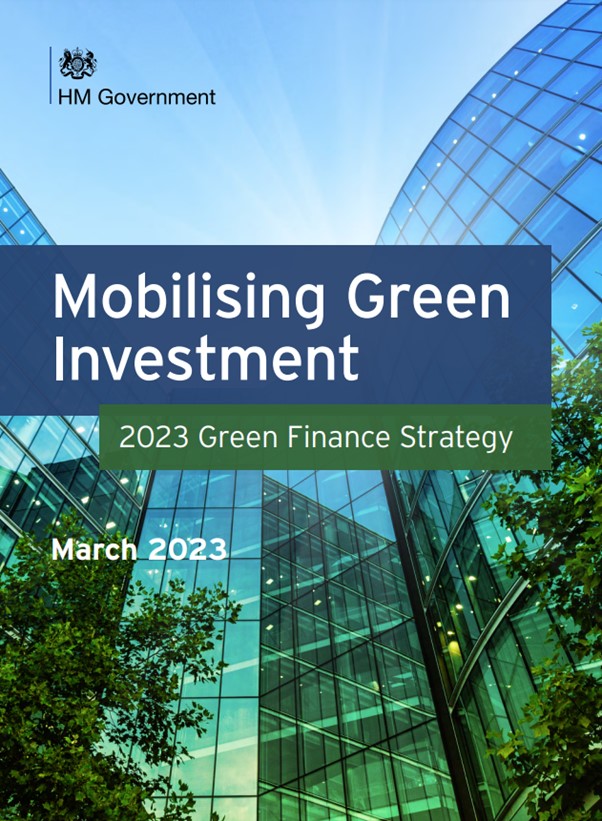UK Green Finance Strategy 2023
Posted on: April 3rd, 2023

On 30 March 2023 the government published its updated Green Finance Strategy.
Related papers include:
- Green Finance Boost for Nature – a framework to develop growth in green finance in UK
- Green Finance strategy welcomed by FCA
A quick skim tells me this important paper is likely to be welcome and useful (both climate and biodiversity are taken seriously) – but not without its critics (nuclear and hydrogen both feature).
The paper is split into three main sections; ‘Foundations’, ‘Align’ and ‘Invest’.
The strategy begins as follows (text pasted from report), please download the full document to read further.
Executive Summary
1. Climate change, biodiversity loss and environmental degradation are transforming the global economy. As countries, companies and individuals across the world respond to these challenges, finance and investment have a crucial role to play. The global transition to a net zero, resilient and nature positive economy will see trillions of pounds reallocated and invested in new projects, products and services. The UK’s world-renowned finance sector can put us at the forefront of this transition.
2. The UK’s COP26 Presidency in 2021 generated historic momentum in the
numbers of businesses, regions and investors seeking to align with climate
and environmental goals. Over 90% of global GDP is now covered by national
net zero targets. In the financial services sector this was exemplified through the
commitment of the Glasgow Financial Alliance for Net Zero (GFANZ), which unites over
550 members across the financial sector committed to align with a net zero future,
spanning 50 countries and representing 40% of global private financial assets.
Now is the time for the UK to build on that leadership.
3. The transition is not only an environmental imperative, but a growth opportunity
for the UK. Supplying the goods and services necessary to reach global net zero
ambitions is estimated to be worth up to £1 trillion to UK businesses to 20302.
Furthermore, exports within low carbon and renewable energy industries are growing
significantly faster than exports from the broader economy. Between 2020 and 2021, it
is estimated exports from these sectors increased by 67%, compared to total exports
which increased by 6%.3
4. The 2023 Green Finance Strategy (‘this Strategy’) is an update to the UK’s
2019 Green Finance Strategy and sets out how continued UK leadership on green
finance will cement the UK’s place at the forefront of this growing global market,
and how we will mobilise the investment needed to meet our climate and nature
objectives. Published alongside this Strategy are the UK government’s Powering Up
Britain, Nature Markets Framework, International Climate Finance Strategy and UK
2030 Strategic Framework for Climate and Nature. Collectively these publications
confirm the UK’s ambition to address climate and environmental challenges, and the
practical steps we are taking to drive progress.
What are our objectives?
This Strategy aims to reinforce and expand the UK’s position as a world leader on
green finance and investment, delivering five key objectives:
a. UK financial services growth and competitiveness – The UK can and will do
more to support our financial services sector to prosper from a transitioning global
economy. From venture capital supporting innovative climate tech solutions , to
banks lending to major renewables projects and asset managers allocating capital
to support the companies of the future – behind every step of our transition will be
our world-leading financial services sector.
b. Investment in the green economy – Private investment will be crucial to delivering
net zero, building climate resilience and supporting nature’s recovery. We estimate
that to deliver on the UK’s net zero ambitions, through the late 2020s and 2030s,
an additional £50-60 billion capital investment will be required each year. A 2021
report estimated that over the next ten years, our domestic nature-related goals
could require between £44-97 billion of investment. This investment will support
the sectors and technologies of the future, enable traditional sectors to adapt and
thrive as part of the transition, and presents a significant opportunity to level up the
UK, including those parts with an industrial heritage.
c. Financial stability – Climate change and environmental degradation pose profound
risks to the economy. The Bank of England projected £110 billion in additional losses
for UK banks out to 2050 in their disorderly transition scenario, and 50-70% higher
losses for UK insurers in their highest climate risk scenario. Similarly, over half the
world’s GDP is generated in sectors that depend on the goods and services nature
provides . An effective green finance framework will ensure the finance sector has
the information it needs to manage risks from climate change and nature loss.
d. Incorporation of nature and adaptation – There has been significant progress
on nature finance both domestically and internationally since 2019, culminating
in the commitments on finance made in the landmark Kunming-Montreal Global
Biodiversity Framework agreed at the UN Convention on Biological Diversity COP
15 in December 2022. There is also increasing recognition of the Government’s
critical role in supporting private investment in climate resilience, as highlighted by
the Climate Change Committee’s recent report. To reflect these developments, as
well as calls from industry for an integrated approach, this Strategy will explicitly
incorporate both nature and climate adaptation into the government’s green finance
policy framework.
e. Alignment of global financial flows with climate and nature objectives – With our
world leading expertise and outward looking financial sector, the UK is strategically
placed to collaborate with international partners to support the alignment of global
financial frameworks and stimulate investment towards emerging and developing
markets where capital needs are highest. The UK can capture a huge economic
opportunity by supporting the global transition, whilst building closer relationships
with high growth emerging markets and developing economies as they seek to meet
their own financing needs.
